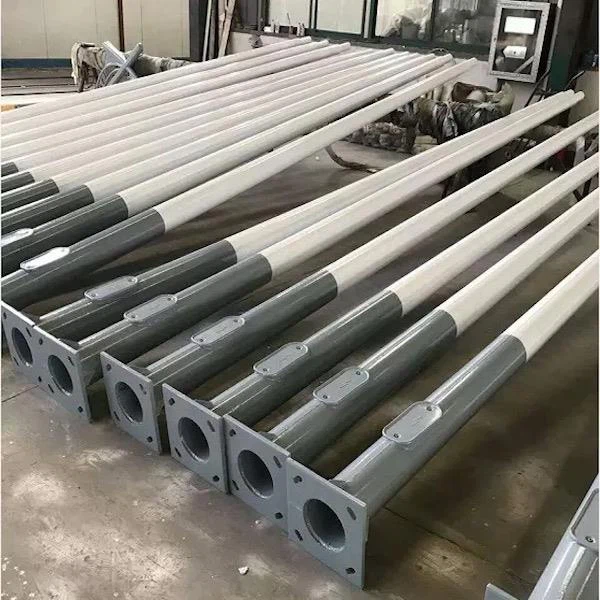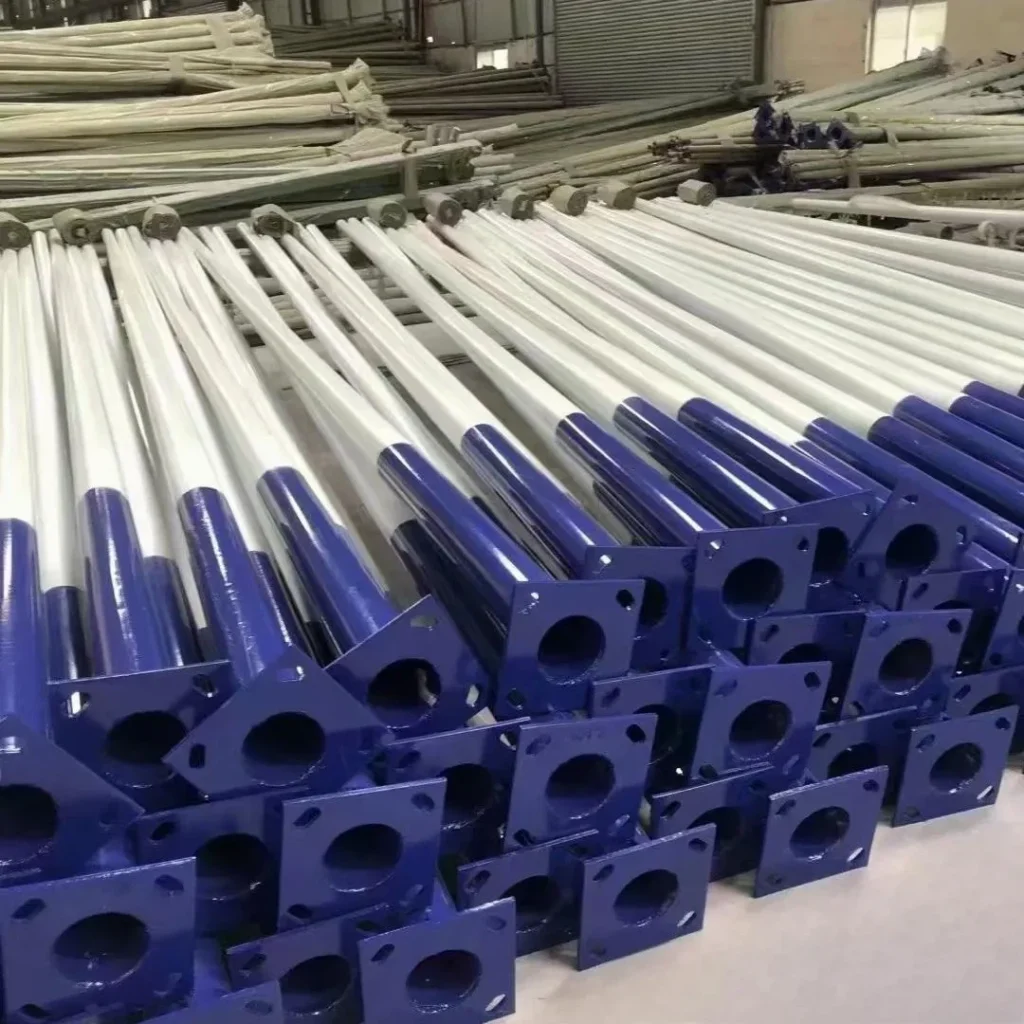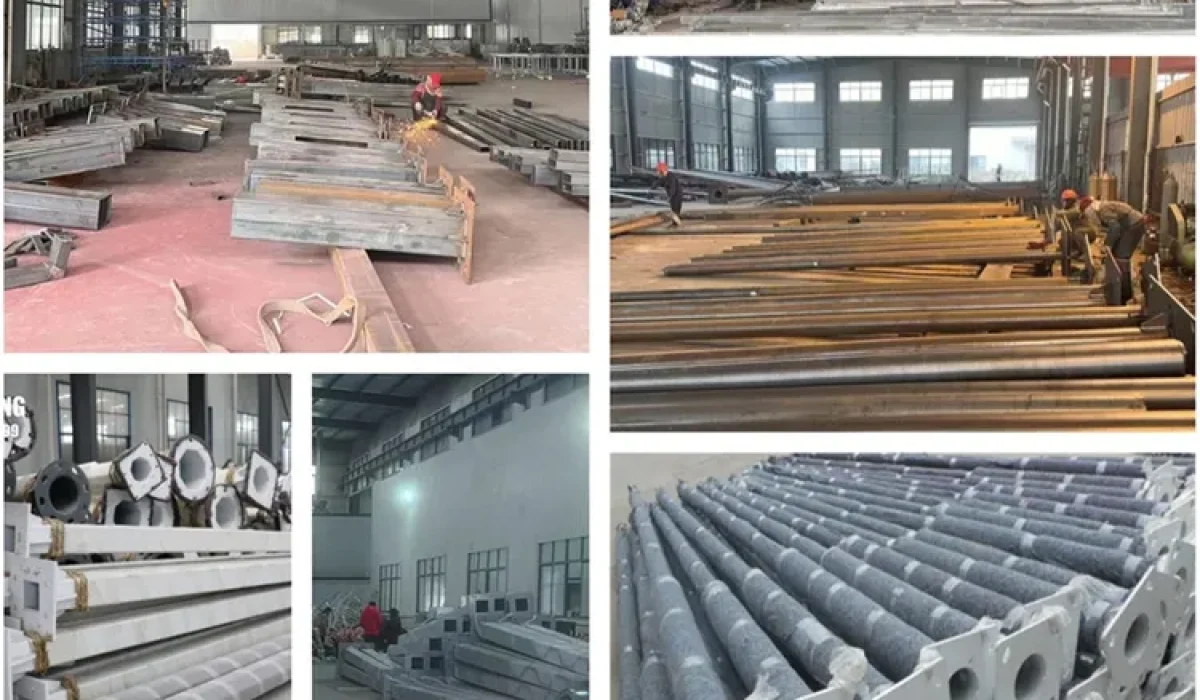As someone who has spent over fifteen years managing infrastructure and solar lighting projects across Africa, I’ve seen one truth repeat itself: street light poles can make or break the reliability of a project. Governments, EPC contractors, and city planners often ask me why some poles last decades while others rust away in just a few years. The answer, in most cases, lies in the choice between painted steel poles and galvanized street light poles.
From the coastal humidity of Mombasa to the dry winds of northern Nigeria, hot-dip galvanized poles have consistently proven to be the most durable and cost-effective solution for large-scale lighting projects.
What Is a Galvanized Street Light Pole?
A galvanized street light pole is a steel pole coated with a protective layer of zinc to prevent rust and extend service life. This process ensures the steel withstands rain, salt, dust, and other harsh environmental conditions.

There are two types of galvanization:
- Hot-dip galvanization – steel is immersed in molten zinc, forming a thick protective layer (≥85μm). This method gives poles a lifespan of 20–30 years.
- Electro-galvanization – a thinner zinc layer applied by electroplating. Cheaper, but typically lasts 5–10 years only.
In my projects, I never recommend electro-galvanized poles for infrastructure use; they simply don’t survive long enough to justify the investment.
Key Benefits of Galvanized Street Light Poles
Based on real project outcomes, here’s why I always advise EPC contractors and procurement officers to choose galvanized poles:
- Corrosion resistance – 20–30 years in service without significant degradation.
- Low maintenance – eliminates frequent repainting and inspection cycles.
- Proven performance in harsh climates – from coastal salt air to desert heat.
- Compliance with global standards – ISO 1461, EN 40, IEC.
Galvanized vs Painted vs Stainless Steel
| Feature | Galvanized Steel Pole | Painted Pole | Stainless Steel Pole |
|---|---|---|---|
| Service Life | 20–30 years | 3–7 years | 25–35 years |
| Corrosion Resistance | High | Low | Very High |
| Cost | Medium | Low | High |
| Maintenance | Minimal | Frequent repainting | Low |
| Best Use Case | Highways, municipal roads | Temporary/low-budget projects | Premium zones (airports, city centers) |
In reality, painted poles may look good in the first year, but by year five, rust spreads quickly. I’ve seen entire tender projects in West Africa fail early simply because the buyer opted for painted poles instead of galvanized.
Technical Specifications & Standards
When evaluating tender documents or preparing a technical bid, these are the parameters I check first:
- Height – 6m, 8m, 10m, 12m standard; 15m for highways.
- Pole types – round, octagonal, or conical.
- Steel grade – Q235 or Q345 high-strength steel.
- Wall thickness – 3mm to 6mm depending on height and wind load.
- Hot-dip galvanization thickness – ≥85μm (ISO 1461 standard).
- Applicable standards – ISO 1461 / EN 40 / IEC.
Applications in Infrastructure Projects
Over the years, I have overseen galvanized street light pole deployments in various sectors:

- Urban roads & highways – consistent illumination reduces accidents.
- Parking lots & municipal squares – safe, low-maintenance lighting.
- Industrial parks & ports – withstands corrosion and heavy-duty use.
Real Case Studies
📌 Kenya – Mombasa Port Expansion (2021)
- Scope: 12m hot-dip galvanized poles for container yard lighting.
- Reason for choice: Salt air corrosion made painted poles unfeasible.
- Outcome: Expected lifespan 25 years, with estimated O&M savings of 40% compared to painted poles.
📌 Nigeria – Lagos–Ibadan Expressway (2020)
- Scope: 2,500 units of 10m octagonal galvanized poles.
- Reason for choice: High wind load and heavy traffic safety requirements.
- Outcome: Improved road safety and reduced maintenance budget by $200,000 annually.
📌 Ethiopia – Addis Ababa City Square Renovation (2019)
- Scope: Decorative 8m galvanized poles with double arms.
- Reason for choice: Needed durability combined with aesthetic appeal.
- Outcome: Enhanced city aesthetics while ensuring 20+ years of performance.
These real-world projects show how galvanized poles balance durability, cost, and compliance with tender specifications.
Choosing the Right Galvanized Street Light Pole
Over the years, I’ve advised dozens of EPC contractors on selecting the correct pole. Here are the rules of thumb:
- Height & diameter – highways require taller poles (10–15m) with stronger bases.
- Thickness & wind pressure – coastal and desert regions require thicker steel (≥4mm).
- Lighting arms – choose single, double, or custom arms depending on road design.
Scenario-based guidance:
- Highways: 12–15m conical poles, thicker wall.
- Parking lots: 8–10m octagonal poles.
- Coastal projects: hot-dip galvanized with thicker zinc coating.
👉 [Get Free Design Consultation]
Price & Supplier Insights
Pricing is one of the first questions I receive in tender negotiations.
- Price factors: pole height, steel thickness, zinc coating, order quantity, and freight.
- Typical range: $80–$250 per pole.
- Bulk advantage: Orders above 500 units reduce unit cost by up to 20%.
- Supplier market: China remains the largest and most competitive supplier for galvanized poles in Africa and the Middle East.
In fact, during the Nigeria expressway tender, our bid was 15% lower than European suppliers due to optimized Chinese manufacturing and bulk logistics.
Procurement & Tendering in African Projects
Many EPC managers underestimate the role of standards and compliance in government tenders. Here’s what I’ve learned:
- Technical compliance is non-negotiable – tender committees reject bids without ISO/EN certifications.
- Local adaptation matters – in coastal Ghana, we had to provide wind load calculations to satisfy engineers.
- After-sales support is critical – some tenders score suppliers based on warranty and technical backup.
- Price transparency – governments prefer bulk packages including poles, luminaires, and installation kits.
If you’re bidding, always attach galvanization certificates, wind load analysis, and sample drawings. These documents often tip the decision in your favor.
FAQ
Q1: What is the lifespan of a galvanized street light pole?
Hot-dip galvanized poles last 20–30 years, depending on climate.
Q2: What is the difference between hot-dip and electro-galvanized poles?
Hot-dip creates a thick, durable zinc layer; electro-galvanized is thinner and less reliable.
Q3: How much does a galvanized street light pole cost?
Typically $80–$250 per unit, depending on size and order volume.
Q4: Can galvanized poles be used in coastal areas?
Yes. Hot-dip galvanized poles are specifically suited for coastal and humid zones.
Conclusion & Call to Action
From Addis Ababa’s city squares to Nigeria’s expressways and Kenya’s ports, I have seen firsthand how galvanized street light poles deliver unmatched durability and cost savings. They are not just a purchase; they are a long-term investment in infrastructure reliability.
If you are preparing for a government tender or planning a municipal lighting project, my advice is simple: choose hot-dip galvanized poles. They meet international standards, reduce lifecycle costs, and secure long-term project success.
👉 Contact Us Now for a Quote
👉 Download Full Catalog
👉 Get Free Design Consultation


